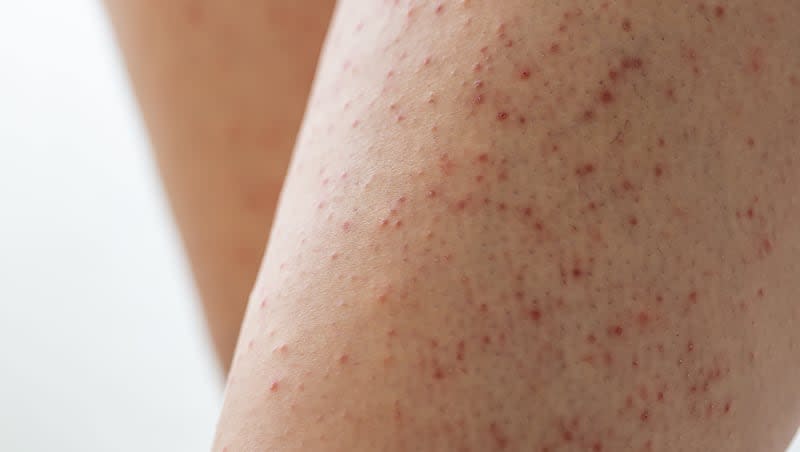What is ‘chicken skin’ and how do I get rid of it?

Keratosis pilaris is also called chicken skin because of its distinctive appearance: skin bumps that look like plucked chicken skin, per Healthline.
These bumps tend to emerge on areas of the skin with hair follicles, such as your upper arms and thighs. Besides bumps, symptoms may include skin discoloration in the area, itchiness, dryness and a sandpaper-like texture, according to Healthline.
What causes the condition? Is it dangerous?
Keratosis pilaris results from the accumulation of keratin, a tough protein that shields the skin from harmful agents and infections. This buildup obstructs the hair follicle openings, leading to the bumpy skin patches, per Mayo Clinic.
Mayo Clinic also shares that experts don’t know why keratin builds up. However, the condition is very common, often genetic and typically clears up in your 20s to 30s even if you don’t treat it.
Individuals prone to skin conditions such as eczema or ichthyosis may be more likely to develop keratosis pilaris. Furthermore, hormonal changes in pregnancy and puberty can cause flare-ups of the condition, per Healthline.
Though the rough, bumpy patches can be annoying, the condition is benign, meaning not harmful, according to Cleveland Clinic.
How to treat chicken skin at home
Per The New York Times, dermatologists overall recommend trying to prevent dry skin to reduce flare-ups and improve the appearance of keratosis pilaris. Here are their specific suggestions:
Use products that contain emollients (moisturizers) and keratolytic agents (salicylic acid or lactic acid) to smooth out bumps and reduce redness.
Apply products right after showering to seal moisture into skin.
Avoid harsh body scrubs or picking the bumps. Use a loofah or washcloth instead.
Avoid products with oils or smells, which can irritate the skin.
After the bumps disappear, continue to moisturize every day and stop using keratolytic products.
Results may take around four to six weeks, according to the American Academy of Dermatology Association.
Eating and chicken skin
According to VeryWell Health, there is no conclusive scientific evidence supporting a specific diet for treating or preventing keratosis pilaris. However, some individuals have reported improvements by adhering to an anti-inflammatory diet that includes vitamins and antioxidants. Few have noted symptom alleviation after eliminating gluten and dairy from their diet. Some of the foods they suggest include:
Fruits and vegetables: Consume foods that are high in vitamin A and antioxidants. Make sure to eat at least five servings per day.
Dairy: Unless you have a dairy allergy, some individuals find dairy can reduce inflammation.
Lean protein: Eat foods that are low in saturated fats such as lean poultry or beans.
Fatty fish: Eat fish that contain omega-3 fatty acids.
Whole grains: Unless you have celiac or a gluten sensitivity, whole grains contain vitamin B and antioxidants.
Water: Keep your body hydrating by drinking water and staying away from alcohol or juices.
What can be mistaken for chicken skin?
There are multiple skin conditions that keratosis pilaris may resemble. Here are some of the more common ones:
Acne pimples (Healthline).
Folliculitis, or inflamed hair follicles (Healthline).
Goosebumps (Healthline).
Milia: White cysts on skin (Medscape).
According to The New York Times, if your chicken skin persists despite months of attempting at-home remedies, it may be time to consult a dermatologist. They can provide prescribed treatments or determine if your condition may be indicative of something else.

